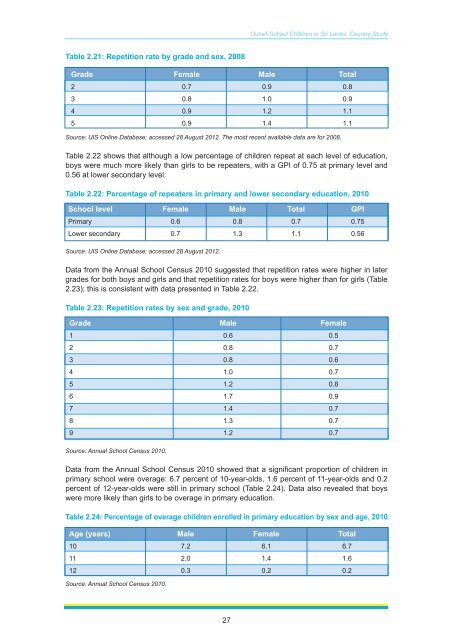Sri Lanka - Institut de statistique de l'Unesco
Sri Lanka - Institut de statistique de l'Unesco
Sri Lanka - Institut de statistique de l'Unesco
Create successful ePaper yourself
Turn your PDF publications into a flip-book with our unique Google optimized e-Paper software.
Out-of-School Children in <strong>Sri</strong> <strong>Lanka</strong>: Country Study<br />
Table 2.21: Repetition rate by gra<strong>de</strong> and sex, 2008<br />
Gra<strong>de</strong> Female Male Total<br />
2 0.7 0.9 0.8<br />
3 0.8 1.0 0.9<br />
4 0.9 1.2 1.1<br />
5 0.9 1.4 1.1<br />
Source: UIS Online Database; accessed 28 August 2012. The most recent available data are for 2008.<br />
Table 2.22 shows that although a low percentage of children repeat at each level of education,<br />
boys were much more likely than girls to be repeaters, with a GPI of 0.75 at primary level and<br />
0.56 at lower secondary level.<br />
Table 2.22: Percentage of repeaters in primary and lower secondary education, 2010<br />
School level Female Male Total GPI<br />
Primary 0.6 0.8 0.7 0.75<br />
Lower secondary 0.7 1.3 1.1 0.56<br />
Source: UIS Online Database; accessed 28 August 2012.<br />
Data from the Annual School Census 2010 suggested that repetition rates were higher in later<br />
gra<strong>de</strong>s for both boys and girls and that repetition rates for boys were higher than for girls (Table<br />
2.23); this is consistent with data presented in Table 2.22.<br />
Table 2.23: Repetition rates by sex and gra<strong>de</strong>, 2010<br />
Gra<strong>de</strong> Male Female<br />
1 0.6 0.5<br />
2 0.8 0.7<br />
3 0.8 0.6<br />
4 1.0 0.7<br />
5 1.2 0.8<br />
6 1.7 0.9<br />
7 1.4 0.7<br />
8 1.3 0.7<br />
9 1.2 0.7<br />
Source: Annual School Census 2010.<br />
Data from the Annual School Census 2010 showed that a significant proportion of children in<br />
primary school were overage: 6.7 percent of 10-year-olds, 1.6 percent of 11-year-olds and 0.2<br />
percent of 12-year-olds were still in primary school (Table 2.24). Data also revealed that boys<br />
were more likely than girls to be overage in primary education.<br />
Table 2.24: Percentage of overage children enrolled in primary education by sex and age, 2010<br />
Age (years) Male Female Total<br />
10 7.2 6.1 6.7<br />
11 2.0 1.4 1.6<br />
12 0.3 0.2 0.2<br />
Source: Annual School Census 2010.<br />
27

















